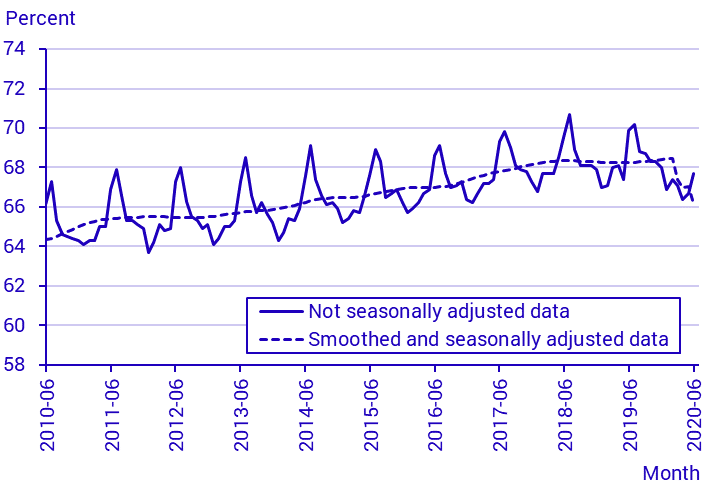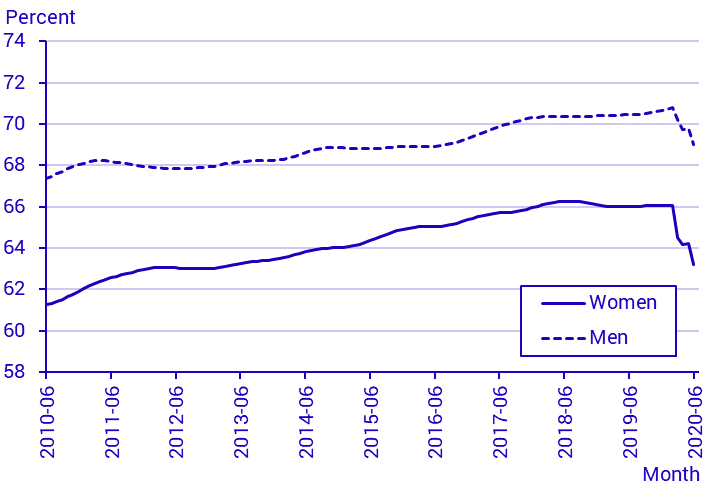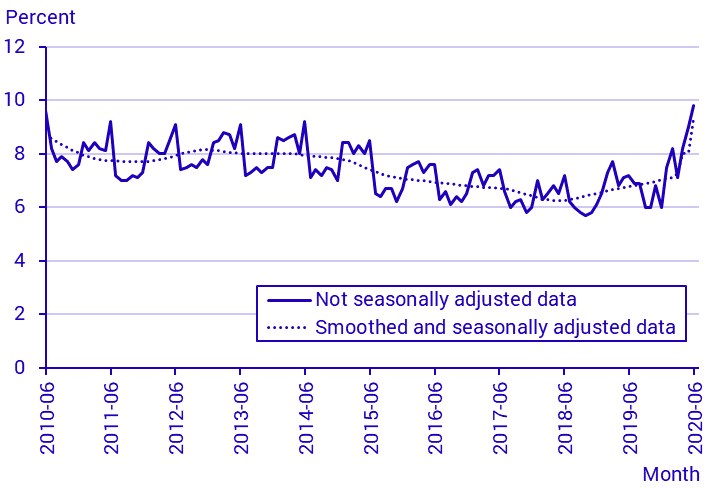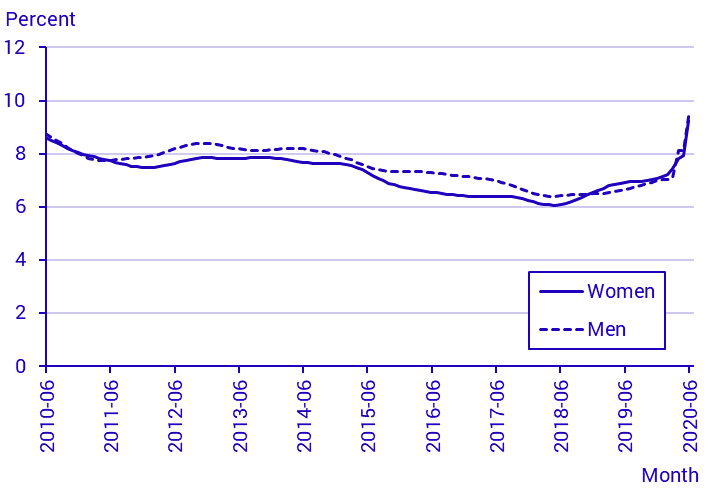Labour Force Surveys (LFS), June 2020
Difficult labour market for young people
Statistical news from Statistics Sweden 2020-07-23 9.30
In June 2020, there were 5 101 000 employed persons, a decrease of 148 000. The largest decrease occurred for women aged 15-24 with temporary employment contracts. The number of unemployed persons increased by 150 000 to 557 000. This corresponds to an unemployment rate of 9.8 percent, an increase of 2.6 percentage points. Among young persons, the unemployment rate increased by 8.7 percentage points to 32.3 percent. The average number of hours worked amounted to 156.4 million hours per week, a decrease of 6.9 percent, calendar-adjusted. Seasonally adjusted and smoothed data show a decrease in employment and an increase in unemployment. The unemployment rate was 9.3 percent.
Labour force
In June 2020, there were 5 658 000 persons aged 15–74 in the labour force, not seasonally adjusted. The number of men in the labour force increased by 50 000 to 2 990 000 and the number of women was 2 667 000. The labour force participation rate was 75.1 percent. Among women it was 72.1 percent, a decrease of 1.5 percentage points, and among men it was 78.0 percent.
Seasonally adjusted and smoothed data show that there were 5 501 000 persons in the labour force, a decrease of 51 000 compared with February 2020, when the effects of the coronavirus (COVID-19) outbreak were not yet discernible in the Swedish labour market. The labour force participation rate was 73.0 percent, a decrease of 0.8 percentage points compared with February 2020. It is notable that the decrease in both the number of persons in the labour force and the share of the population in the labour force has flattened off in the last three months.
Employment
In June 2020, there were 5 101 000 employed persons aged 15─74, not seasonally adjusted. This represents a decrease of 148 000 persons compared with the same month a year ago, of which 84 000 were young persons aged 15-24. There were 2 408 000 employed women. This represents a decrease of 111 000, of which 54 000 were young persons. There were 2 693 000 employed men. The employment rate was 67.7 percent, a decrease of 2.2 percentage points. Among women, the employment rate was 65.1 percent, a decrease of 3.2 percentage points, and among men it was 70.2 percent.
Seasonally adjusted and smoothed data show that there were 4 987 000 employed persons. This is 169 000 fewer than in February 2020, of which 73 000 were young persons. The employment rate was 66.2 percent, a decrease of 2.3 percentage points compared with February 2020.
Employees
In June 2020, there were 4 606 000 employees, not seasonally adjusted. Compared with the same month a year ago this is a decrease of 132 000, of which 107 000 were women. There were 3 879 000 permanent employees, and 727 000 temporary employees. The number of temporary employees decreased by 126 000 persons compared with the same month a year ago, of which 95 000 were women. Among young persons aged 15-24, there was a decrease of 57 000 in the number of temporary employees.
Compared with February 2020, seasonally adjusted and smoothed data show that there were 146 000 fewer employed persons, of which 127 000 were temporary employees.
Hours worked
On average, the number of hours worked in June 2020 amounted to 156.4 million per week, not seasonally adjusted. This represents a decrease of 6.9 percent, calendar adjusted, compared with the same month a year ago. The largest decrease was in Hotels and restaurants, where the number of hours worked, calendar-adjusted, decreased by 41.1 percent compared with June 2019. Transport decreased by 34.9 percent and Manufacturing of machinery and transport equipment decreased by 18.5 percent. A decrease was also noted in Trade.
Seasonally adjusted and smoothed data show that the average number of hours worked was 142.1 million hours per week, which is 13.3 million hours less per week than in February. The decrease has, however, levelled off in recent months since the number of hours worked in June is at the same level as in April and May.
In work and absence
There were 4 480 000 persons employed and in work in June 2020, not seasonally adjusted. This corresponds to a decrease of 4.3 percent, calendar adjusted, compared with the same month a year ago. The LFS estimates the number of persons who were absent for the whole week or for part of the week from their principal occupation by main reason for absence. There were 629 000 persons absent for the whole week, not seasonally adjusted, which is 88 000 fewer than in June 2019. Among these, 130 000 were absent due to illness, an increase of 38 000. The number of persons absent for the whole week due to lack of work increased to 34 000 and those absent due to lay-offs increased to 29 000. Furthermore, the number of persons who were absent due to holidays decreased by 172 000. It is common for persons who are absent due to lack of work or lay-offs to be absent only for a part of the week. The total number of persons absent for the whole week or part of the week due to lay-offs increased to 232 000. The corresponding figure for persons who stated lack of work as the main reason for their absence was 79 000, an increase of 42 000.
Seasonally adjusted and smoothed data show that there were 4 139 000 persons in work, which was 230 000 fewer than in February 2020. The decrease has, however, levelled off in recent months since the number of persons in work in June was at approximately the same level as in April and May. There were 848 000 persons absent for the whole week, which is 61 000 more than in February.
Unemployment
In June 2020, there were 557 000 unemployed persons aged 15─74, not seasonally adjusted, amounting to an increase of 150 000 persons compared with the same month a year ago. This corresponds to an unemployment rate of 9.8 percent, an increase of 2.6 percentage points. The number of unemployed men increased by 87 000 to 298 000, and the number of unemployed women increased by 64 000 to 259 000. Among men, the unemployment rate increased by 2.8 percentage points to 10.0 percent and among women it increased by 2.5 percentage points to 9.7 percent. Among young persons aged 15─24, there were 238 000 unemployed persons, an increase of 58 000 persons. This corresponds to a youth unemployment rate of 32.3 percent, an increase of 8.7 percentage points.
For persons aged 15-74, seasonally adjusted and smoothed data show an increase of 118 000 in the number of unemployed persons and an increase of 2.2 percentage points in the unemployment rate, compared with February 2020. In June 2020, there were 513 000 unemployed persons, which corresponds to an unemployment rate of 9.3 percent. Among young persons aged 15─24, smoothed and seasonally adjusted data show an increase in both the number of unemployed persons and the unemployment rate compared with February 2020. The number of unemployed young persons increased by 48 000 to 173 000 persons, and the youth unemployment rate increased by 8.8 percentage points to 28.7 percent.
Impact of COVID-19 on the labour market
In view of the ongoing coronavirus (COVID-19) pandemic, additional questions concerning the impact of COVID-19 have been added to the LFS. Based on these questions, 122 000 employed persons aged 15–74 years stated that they were absent during the whole reference week in June, related to COVID-19. This means that among persons who were absent during the entire reference week, 19.6 percent were absent due to COVID-19. The proportion among men was 23.3 percent and 16.8 percent among women.
Among employees aged 15–74 years who were absent during the entire reference week, 17.3 percent, which corresponds to 99 000 persons, stated that their absence was linked to COVID-19. The proportion was 19.9 percent among men and 15.5 percent among women. Furthermore, among employees who were absent during part of the reference week, 24.2 percent, corresponding to 287 000 persons, stated that their absence was linked to COVID-19. Among self-employed persons and assisting household members aged 15–74 years, 41.7 percent felt that they had less work due to the coronavirus pandemic, while 14.2 percent felt that they had more work.
Among persons who were not employed and who have left their employment since March, 123 000 stated that this was as a consequence of the pandemic.
To be classified as unemployed in the LFS, a person must be without a job, must be able to start work and must have sought work. This means that people who are without a job, but who have not been seeking work or are not available to start work, are not defined as unemployed, but are defined, instead, as not in the labour force. In June 2020, 1 878 000 persons aged 15–74 years were not in the labour force. Among these people, 89 000 persons stated that they would have been able to start work, but had not been seeking work due to COVID-19. In addition, 31 000 persons stated that they would have been unable to start work due to COVID-19.




Next publishing will be
2020-08-20 at 9:30.
Feel free to use the facts from this statistical news but remember to state Source: Statistics Sweden.
